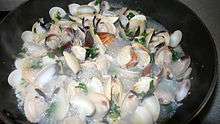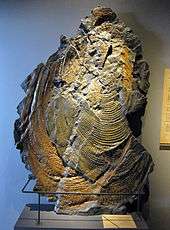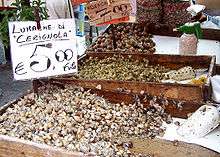Clam
| Clam | |
|---|---|
| Edible clams in the family Veneridae | |
| Scientific classification | |
| Kingdom: | Animalia |
| Phylum: | Mollusca |
| Class: | Bivalvia |
Clam is a common name for several kinds of bivalve molluscs. The word is often applied only to those that are edible and live as infauna, spending most of their lives partially buried in the sand of the ocean floor. Clams have two shells of equal size connected by two adductor muscles and have a powerful burrowing foot.[1] Clams in the culinary sense do not live attached to a substrate (whereas oysters and mussels do) and do not live near the bottom (whereas scallops do). In culinary usage, clams are commonly eaten marine bivalves, as in clam digging and the resulting soup, clam chowder. Many edible clams such as palourde clams are oval or triangular;[2] however, razor clams have an elongated parallel-sided shell, suggesting an old-fashioned straight razor.[3]
Some clams have life cycles of only one year, while at least one may be over 500 years old.[4] All clams have two calcareous shells or valves joined near a hinge with a flexible ligament, and all are filter feeders.

Anatomy

A clam's shell consists of two (usually equal) valves, which are connected by a hinge joint and a ligament that can be external or internal. The ligament provides tension to bring the valves apart, while one or two adductor muscles can contract to close the valves. Clams also have kidneys, a heart, a mouth, a stomach, a nervous system and an anus. Many have a siphon.
As food


North America
In culinary use, within the eastern coast of the United States and large swathes of the Maritimes of Canada, the term "clam" most often refers to the hard clam Mercenaria mercenaria. It may also refer to a few other common edible species, such as the soft-shell clam, Mya arenaria and the ocean quahog, Arctica islandica. Another species commercially exploited on the Atlantic Coast of the United States is the surf clam Spisula solidissima. Scallops are also used for food nationwide, but not cockles: they are more difficult to get than in Europe because of their habit of being farther out in the tide than European species.[5] Up and down the coast of the Eastern U.S., the bamboo clam, ensis directus, is prized by Americans for making clam strips although because of its nature of burrowing into the sand very close to the beach, it cannot be harvested by mechanical means without damaging the beaches.[6]
On the U.S. West Coast, there are several species that have been consumed for thousands of years, evidenced by middens full of clamshells near the shore and their consumption by tribes like the Chumash of California and Nisqually of Washington State.[7][8][9]The butter clam, Saxidomus gigantea,[10] the Pacific razor clam, Siliqua patula, [11] gaper clams Tresus capax,[12] the geoduck clam, Panopea generosa [13]and the Pismo clam, Tivela stultorum [14]are all eaten as delicacies.
Clams can be eaten raw, steamed, boiled, baked or fried. They can also be made into clam chowder, clams casino, Clam cakes, stuffies, or they can be cooked using hot rocks and seaweed in a New England clam bake. On the West Coast, they are an ingredient in making cioppino and local variants of ceviche[15]
Japan
In Japan, clams are often an ingredient of mixed seafood dishes. They can also be made into hot pot, miso soup or Tsukudani. The more commonly used varieties of clams in Japanese cooking are the Shijimi (Corbicula japonica), the Asari (Venerupis philippinarum) and the Hamaguri (Meretrix lusoria).
Italy
In Italy, clams are often an ingredient of mixed seafood dishes or are eaten together with pasta. The more commonly used varieties of clams in Italian cooking are the Vongola (Venerupis decussata), the Cozza (Mytilus galloprovincialis) and the Tellina (Donax trunculus). Though Dattero di mare (Lithophaga lithophaga) was once eaten, overfishing drove it to the verge of extinction (it takes 15 to 35 years to reach adult size and could only be harvested by smashing the calcarean rocks that form its habitat) and the Italian government has declared it an endangered species since 1998 and its harvest and sale are forbidden.
India
Clams are eaten more in the coastal regions of India, especially in the Konkan, Kerala, Bengal and Karnataka regions.
In Kerala clams are used to make curries and fried with coconut. In Malabar region it is known as "elambakka" and in middle kerala it is known as "kakka". Clam curry made with coconut is a dish from Malabar especially in the Thalassery region. On the south western coast of India, also known as the Konkan region of Maharashtra, clams are used in curries and side dishes, like Tisaryachi Ekshipi, which is clams with one shell on. Beary Muslim households in the Mangalore region prepare a main dish with clams called Kowldo Pinde.
Trinidad and Tobago
Local fishermen sell them in rural markets.
Religion
In Judaism, clams are considered non-kosher (treif) along with all other shellfish, which lack a fish's fins and scales.[16]
As currency
Some species of clams, particularly Mercenaria mercenaria, were in the past used by the Algonquians of Eastern North America to manufacture wampum, a type of sacred jewelry; and to make shell money.[17]
Species

Edible:
- Grooved carpet shell: Ruditapes decussatus
- Hard clam or Northern Quahog: Mercenaria mercenaria
- Manila clam: Venerupis philippinarum
- Soft clam: Mya arenaria
- Atlantic surf clam: Spisula solidissima
- Ocean quahog: Arctica islandica
- Pacific razor clam: Siliqua patula
- Pismo clam: Tivela stultorum (8 inch shell on display at the Pismo Beach Chamber of Commerce)
- Geoduck: Panopea abrupta or Panope generosa (largest burrowing clam in the world)
- Atlantic jackknife clam: Ensis directus
- Lyrate Asiatic hard clam: Meretrix lyrata
- Ark clams, family Arcidae (most popular in Indonesia and Singapore)
Not usually considered edible:
- Nut clams or pointed nut clams, family Nuculidae
- Duck clams or trough shells, family Mactridae
- Marsh clams, family Corbiculidae
- File clams, family Limidae
- Giant clam: Tridacna gigas
- Asian or Asiatic clam: genus Corbicula
- Peppery furrow shell: Scrobicularia plana
See also
- Clam juice
- List of clam dishes – dishes and foods prepared using clams
- Shipworm
- Water purification
- Mussel
References
- ↑ "Clam". Encyclopædia Britannica. Encyclopædia Britannica. 2016.
- ↑ "Clams recipes". BBC. Retrieved 23 February 2017.
- ↑ "Clam". Oxford Dictionaries – Dictionary, Thesaurus, & Grammar.
- ↑ Danielle Elliot (14 November 2013). "Ming the Clam, World's Oldest Animal, Was Actually 507 Years Old". CBS News. Retrieved 15 November 2013.
- ↑ "harvesting cockles".
- ↑ "dredging of clams" (PDF).
- ↑ "Shell Midden Analysis". science.jrank.org. Retrieved 2018-03-10.
- ↑ "Nisqually People and the River – Yelm History Project". www.yelmhistoryproject.com. Retrieved 2018-03-10.
- ↑ "What Did the Chumash Eat? | Synonym". Retrieved 2018-03-10.
- ↑ "Plenty of clams, oysters in Puget Sound and Hood Canal". The Seattle Times. 2015-06-27. Retrieved 2018-03-10.
- ↑ Kelly, Mike. "Dig Those Razor Clams". North Coast Journal. Retrieved 2018-03-10.
- ↑ Lackner, Bill. "Oregon clam chowder". Coos Bay World. Retrieved 2018-03-10.
- ↑ "All About Geoduck: The Life of a (Delicious) Oversized Mollusk". www.seriouseats.com. Retrieved 2018-03-10.
- ↑ "Digging for Pismo clams at San Diego Beaches". Retrieved 2018-03-10.
- ↑ "razor clams | Langdon Cook". langdoncook.com. Retrieved 2018-03-16.
- ↑ Shulchan Aruch, Yoreh De'ah 83 and 84
- ↑ Kurlansky, Mark (2006), The Big Oyster: History on the Half Shell, Penguin Group, pp. 16, 30–31, ISBN 978-0-345-47638-8, OCLC 60550567.
External links
| Look up clam in Wiktionary, the free dictionary. |

- Clam stir fry
- Deep In The Ocean A Clam That Acts Like A Plant Science Daily March 2, 2007
- Hardshell Clams

